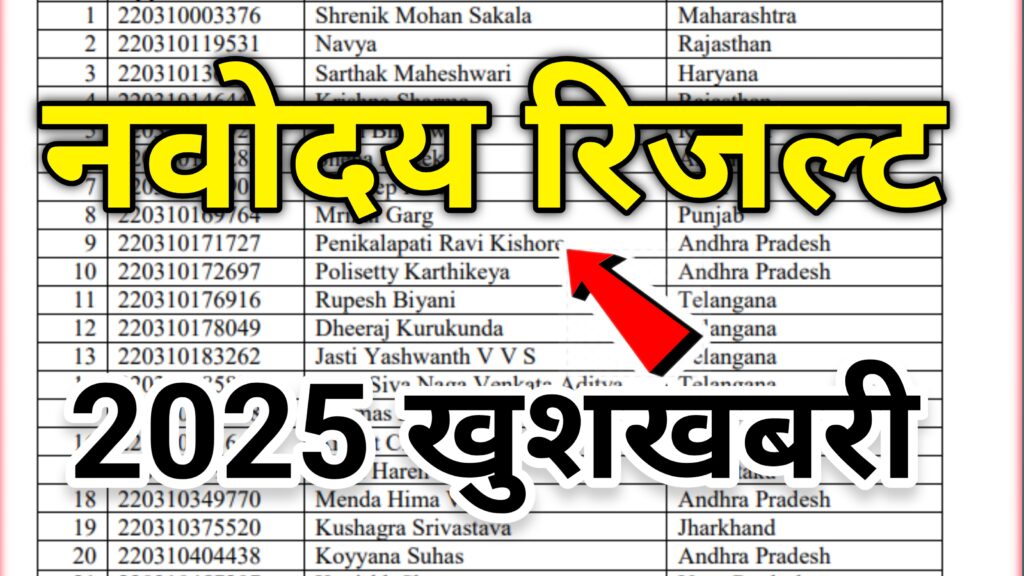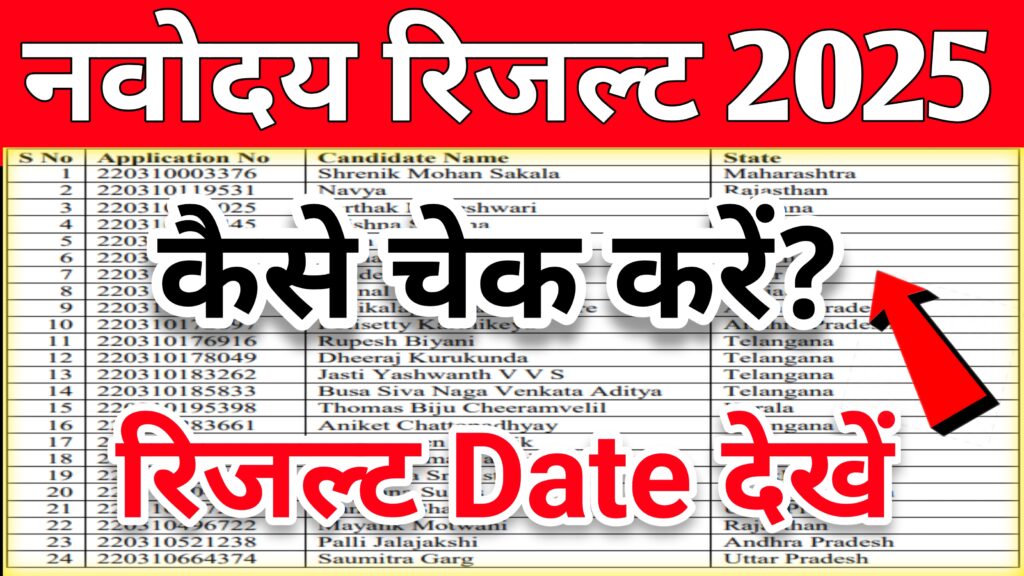About JNV (Jawahar Navodaya Vidyalaya) Admission
Jawahar Navodaya Vidyalayas (JNVs) are a network of prestigious government schools in India that offer quality education to students, primarily from rural and underserved areas. These schools are affiliated with the Central Board of Secondary Education (CBSE) and aim to promote excellence in education, particularly among talented children, regardless of their background.
The admissions for JNVs are held for classes 6, 9, and 11. The most common admission process is for Class 6, which is done through an entrance exam. Here’s an overview of the admission process:
NAVODAYA VIDYLAYA CLASS 6 RESULT DATE CHECK NOW
EXAM DATE |
18 JANUARY 2025 |
RESULT DATE |
CHECK DATE |
RESULT FINAL DATE |
CHECK RESULT |
Selection Test(ClassVI) 2025 Result
For Class 6 Admission:
- Age: The child should be between 9 to 13 years as of May 1 of the year in which the admission is sought.
- Educational Qualification: The student should have passed Class 5 from a recognized school.
- Residential Requirement: Preference is given to children from rural areas, and the school focuses on children whose families are economically weaker.
- Reservation: There are provisions for reservation under various categories (e.g., SC/ST, OBC, Divyang).
For Class 9 Admission:
- Students who have passed Class 8 from a recognized school are eligible.
- The age limit is similar to Class 6, but there are additional tests conducted by JNV.
For Class 11 Admission:
- Admissions are usually based on the marks obtained in the Class 10 CBSE exams.
- Students must apply through the JNV of their respective region.
2. Entrance Exam for Class 6 (JNVST – Jawahar Navodaya Vidyalaya Selection Test)
-
Exam Date: The exam is typically held in April every year. The exact date is announced by NVS (Navodaya Vidyalaya Samiti) on their website.
-
Syllabus: The JNVST for Class 6 generally assesses the child on:
- Mental Ability (e.g., pattern recognition, logical reasoning).
- Arithmetic (basic mathematical skills like addition, subtraction, multiplication, division).
- Language Ability (reading comprehension and basic grammar).
-
Mode of Exam: The exam is conducted in offline mode (pen-paper based) and is usually in multiple-choice question (MCQ) format.
-
Language: The test is conducted in the medium of Hindi, English, and the regional language.
-
Selection Process: The final selection is based on the marks obtained in the entrance test. Shortlisted students are then called for medical examination.
3. Application Process
-
Online Application: You can apply for the JNVST exam through the official NVS website or directly through the nearest JNV.
-
Offline Application: Some JNVs may allow you to submit the application form offline at the school or nearest education office.
-
Important Documents: You will need a birth certificate, proof of residence, passport-sized photographs, and other documents to complete the application.
-
Application Fees: There is no application fee for the JNVST.
4. Reservation Policy
- Rural Areas: 75% of seats in each JNV are reserved for students from rural areas.
- Category-wise Reservations:
- SC/ST: Reservations for Scheduled Castes and Scheduled Tribes are provided as per government norms.
- Girls: There is a 33% reservation for girls in the total seats.
- Divyang (Physically Disabled): 3% of seats are reserved for children with disabilities.
5. Admission Process After Selection
-
Results: The results of the JNVST are usually announced online, and selected students will be called for medical fitness checks.
-
Document Verification: After selection, a set of documents (birth certificate, marksheets, and residence proof) must be verified at the respective JNV.
-
Final Admission: Once everything is verified and the medical fitness is confirmed, students will be admitted to the respective JNV.
6. Facilities Offered by JNVs
- Free Education: JNVs provide free education from Class 6 to Class 12, including free boarding, lodging, and textbooks.
- Sports and Cultural Activities: The schools emphasize the holistic development of students, offering various sports, extracurricular activities, and cultural programs.
- Science and Technology: JNVs have modern infrastructure, including science labs, computer labs, and libraries.
- Hostel Facilities: The schools provide hostel accommodation, which helps students from distant areas to stay and study.
7. JNVST Results & Notifications
- Official Website: You can visit the official site (navodaya.gov.in) for updates, application forms, admit cards, and results.
- Result Date: The results for Class 6 are usually declared within a couple of months after the entrance exam. You can check the result using your roll number or application number.
Summary:
- JNV Admission is a great opportunity for talented children from rural areas to access quality education.
- Class 6 admissions are based on the JNVST entrance exam, which tests basic knowledge in reasoning, mathematics, and language skills.
- No fees are charged for education, making JNVs an excellent choice for families who need financial assistance.
1. When and Where to Check the JNV Result?
-
Result Announcement Date:
- The Class 6 JNVST results are usually announced in May or June (following the exam, which typically takes place in April).
- Exact dates for result announcements are published on the official NVS website and other regional websites of JNVs.
-
Official Websites for Results:
- Main NVS Website: https://navodaya.gov.in
- Result Portal: https://cbseitms.nic.in (where the results are often uploaded after the exams).
Depending on your region, results may also be posted on the regional JNV website.
2. How to Check the JNV Result?
-
Step 1: Visit the Official Result Website
Go to the official result portal (https://cbseitms.nic.in) or the specific JNV regional website. -
Step 2: Select the Relevant Result Link
Look for the link related to the JNVST Class 6 Result for the year in question. It will usually be marked clearly, for example: “Result of JNVST 2025 Class VI”. -
Step 3: Enter Your Details
You’ll be required to enter your roll number, application number, or date of birth to access your result. -
Step 4: Download or Print Your Result
After submitting the details, the result will be displayed. You can either download or print it for future reference.
3. What Does the JNV Result Include?
-
Selection Status:
The result will confirm whether you have been selected for admission to a JNV or not. -
Merit List:
If selected, your name will appear in the merit list. There may be additional merit lists released for students on the waiting list. -
Details Included:
Your result will generally include the following:- Candidate Name
- Roll Number
- Region
- Exam Center
- Marks/Score
- Final Selection Status (Admitted/Not Admitted)
4. Post-Result Steps After Selection
-
Medical Examination:
Once the result is announced and you are selected, a medical examination is conducted to ensure the student is fit to attend the school. -
Document Verification:
The next step is to verify all the necessary documents (e.g., birth certificate, residential proof, category certificate if applicable, etc.) to confirm the admission. -
Admission Confirmation:
After the medical examination and document verification, your admission will be confirmed. The school authorities will provide further details regarding reporting dates, uniforms, and other preparations.
5. Waiting List
If you are not selected in the initial list, there may still be a chance if some seats remain vacant or due to any dropouts. JNVs usually release a waiting list with students who are next in line for admission. If any seats open up, these students are contacted for admission.
-
The waiting list is typically valid for a few months after the initial result.
-
Check Regularly: It’s important to check the JNV website or contact the school if you’re on the waiting list to know when seats may become available.\
6. Important Notes About the JNV Result:
-
No Personal Intimation:
JNVs do not usually send individual notifications (letters, emails, etc.) to the candidates regarding their results. It’s essential to regularly check the official websites for updates. -
Check the Correct Region:
Since JNVs are spread across multiple regions in India, make sure you’re checking the right regional portal for your specific JNV (this will depend on the region your application was submitted to).

